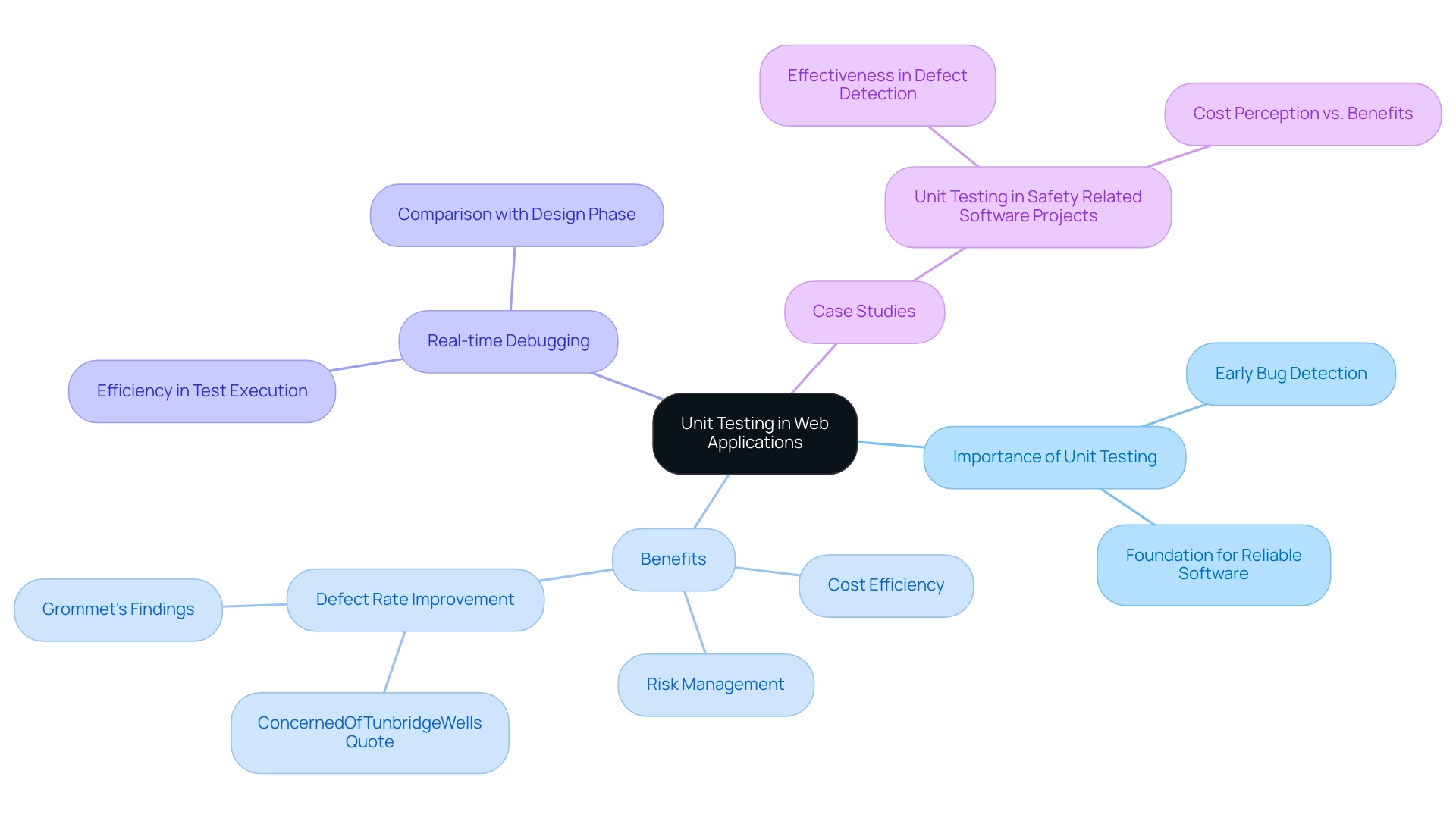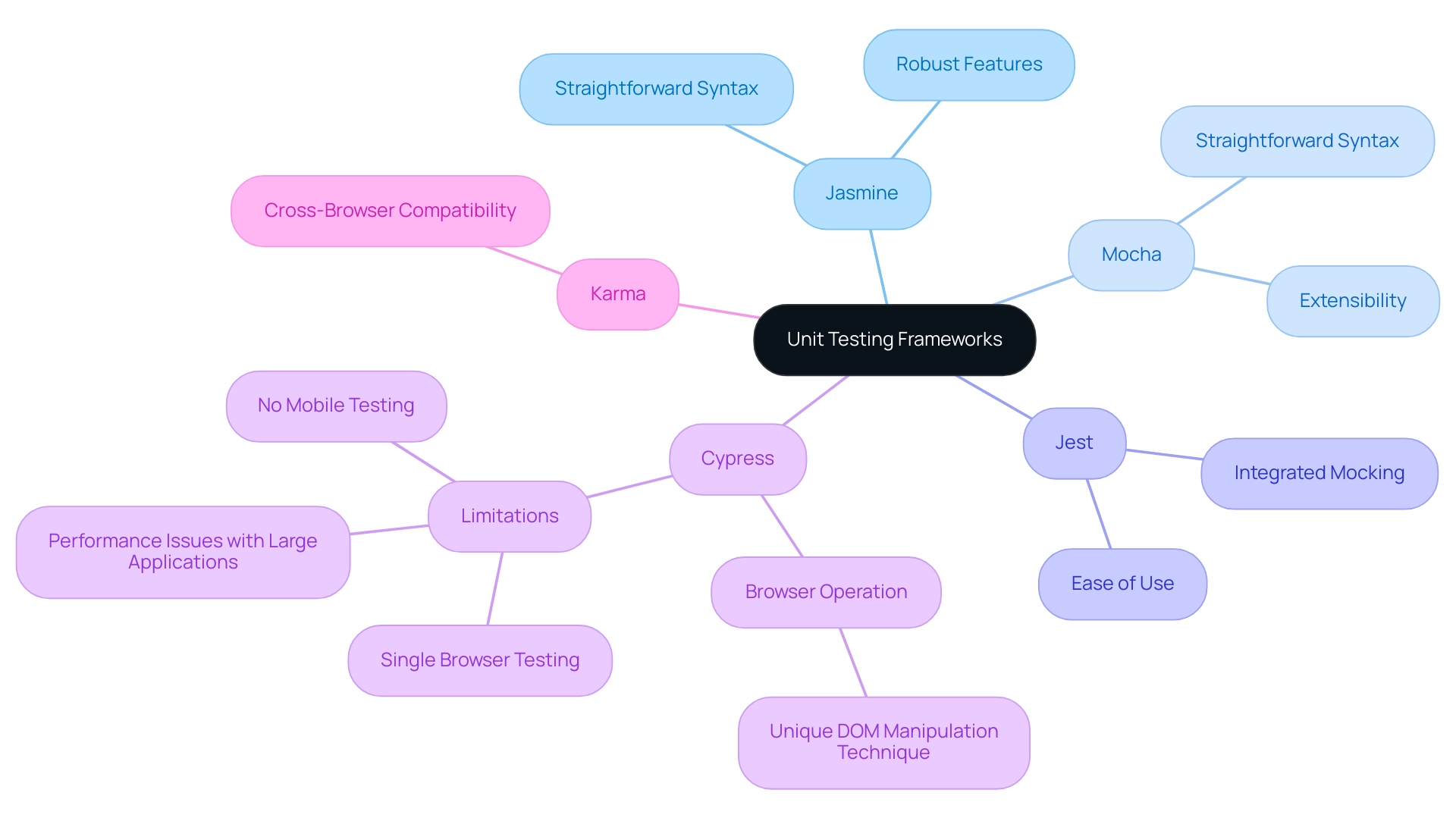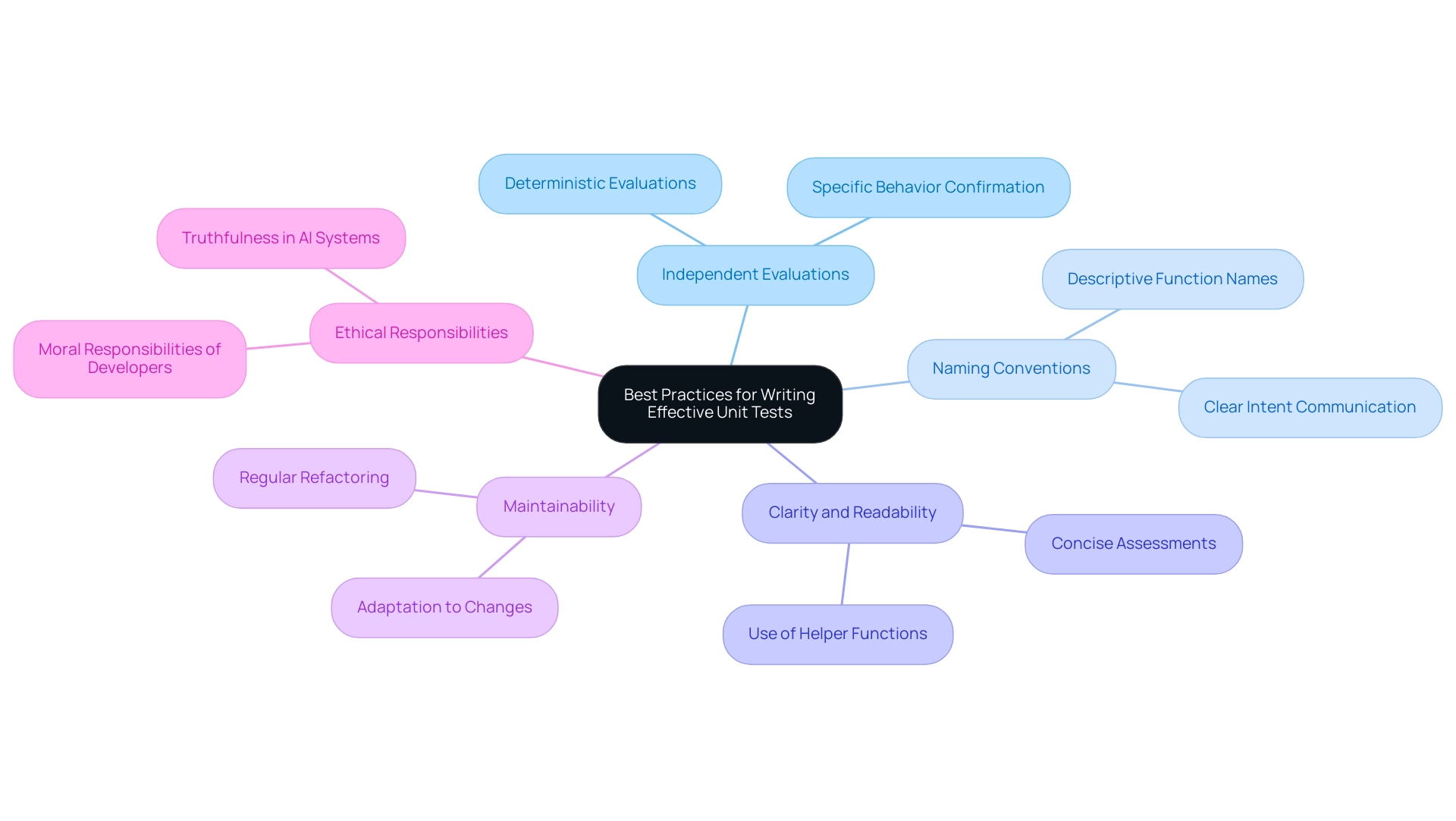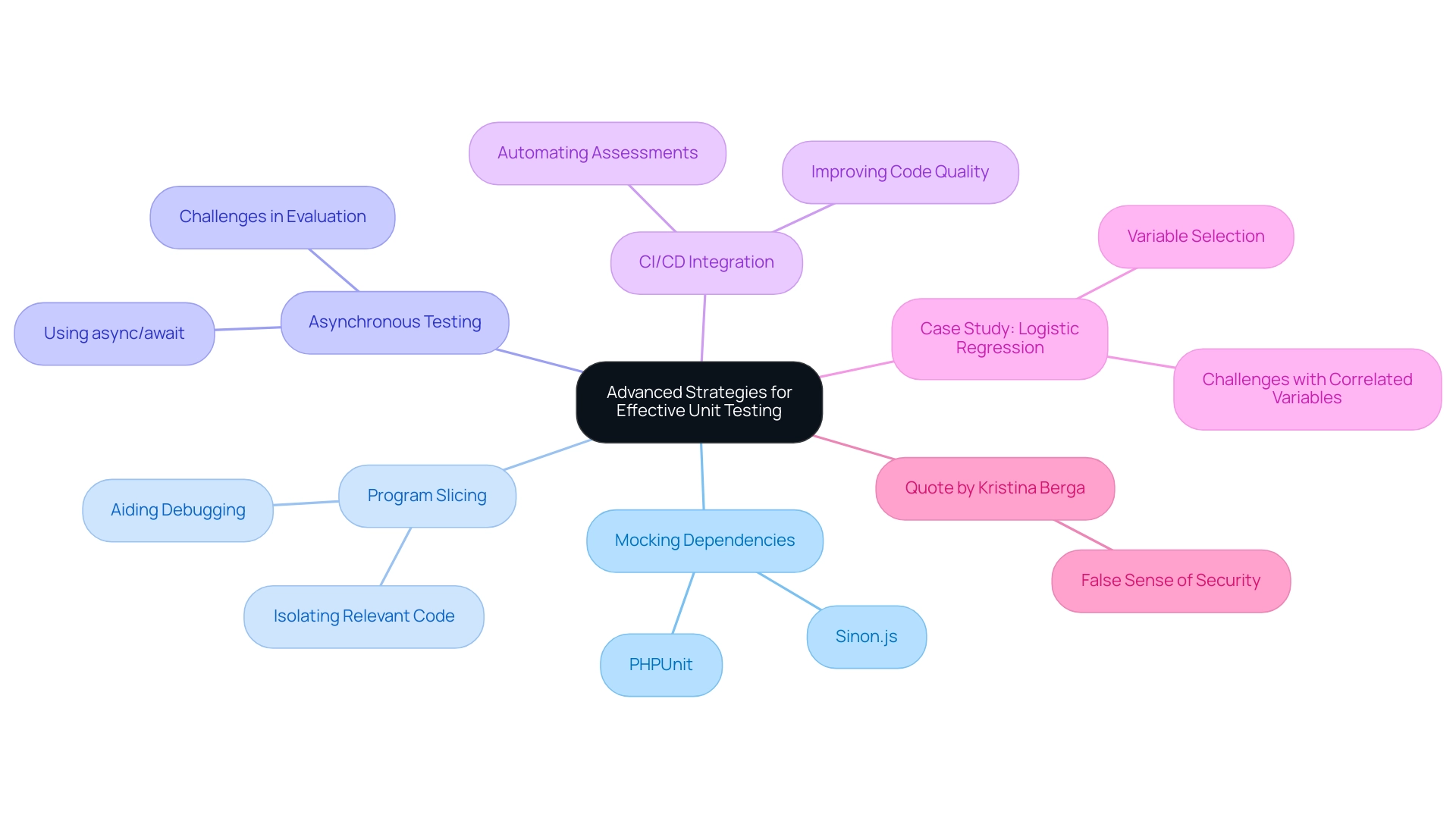Introduction
In the realm of web application development, the importance of unit testing cannot be overstated. This foundational practice not only helps in identifying bugs early in the development cycle but also plays a crucial role in managing risks and preventing costly regressions. As developers navigate the complexities of building reliable applications, understanding the nuances of unit testing becomes essential.
From selecting the right tools and frameworks to adopting best practices and advanced strategies, each aspect contributes to creating a robust testing environment. This article delves into the critical components of unit testing, providing insights that empower developers to enhance their testing methodologies and ultimately deliver high-performing web applications.
Understanding Unit Testing: A Foundation for Web Applications
Unit testing web applications serves as a critical software evaluation technique in which individual components of a web application are assessed in isolation to verify their functionality. This essential practice not only facilitates the early detection of bugs but also significantly mitigates the costs and time associated with debugging later in the development cycle. Studies suggest that investing in modular evaluations can aid in managing risks and avoiding regressions in products.
As expressed by ConcernedOfTunbridgeWells, > Without excessive gesturing you can attribute at least a significant enhancement in defect rates to the module assessment.
Significantly, Grommet's discoveries showed that component evaluation uncovered more flaws during test execution than in the design phase, highlighting its efficiency in real-time debugging. Moreover, a case study titled 'Testing in Safety Related Software Projects' examined three safety-critical software projects and concluded that the perceived costs of testing may be exaggerated, with significant benefits in defect detection relative to those costs.
By ensuring that each piece of code operates as intended, developers can establish a solid groundwork for their software. For instance, consider an e-commerce platform where a bug in the transaction handling component might prevent payment processing; such an issue could lead to substantial revenue losses. Consequently, comprehending and executing unit testing web applications is essential for developers aiming to create dependable and high-performing web solutions.

Essential Tools and Frameworks for Unit Testing
In the realm of unit testing web applications, several frameworks have emerged as leaders, each offering distinct benefits. Jasmine and Mocha stand out in the JavaScript realm, known for their straightforward syntax and robust features that cater to both novice and experienced developers. These frameworks enable smooth incorporation into evaluation workflows, making them suitable for the unit testing web applications and various application needs.
Meanwhile, Jest, created by Facebook, is quickly gaining popularity because of its ease of use and integrated mocking features, simplifying the evaluation process. It's important to note that Cypress, an open-source tool for unit testing web applications, operates directly within the browser using a unique DOM manipulation technique. However, it has the limitation of executing evaluations in a single browser, which can affect cross-browser assessment efforts.
As Pekka Klarck, the creator of Cypress, stated, 'It was developed by Pekka Klarck in 2005 as a method to automate evaluations for Nokia's mobile phones.' For cross-browser compatibility, unit testing web applications with Karma serves as an effective test runner, executing tests in real browsers to ensure consistent program performance across different platforms. A case study on Cypress emphasizes its capability to support contemporary web technologies and operate on various operating systems, enabling real-time debugging, although it does not accommodate mobile evaluations and can face performance challenges with large software.
As the e-commerce landscape evolves, it is crucial for developers to carefully assess unit testing web applications in relation to their specific project needs, team expertise, and existing integration capabilities. This strategic evaluation can significantly enhance the efficiency and effectiveness of testing, ultimately leading to more robust web applications.

Best Practices for Writing Effective Unit Tests
To create effective assessments for unit testing web applications, developers must prioritize several foundational practices, particularly ensuring that evaluations are independent and deterministic. Each component evaluation should confirm a specific behavior or output to remove ambiguity and improve clarity. For instance, in the Calculator class, the add method provides the total of 5 and 3, which amounts to 8, illustrating how individual evaluations can confirm specific behaviors.
As Kilian Foth aptly puts it,
You should evaluate the distribution of results in a 'single' unit run, i.e., that the result is as close to the desired distribution as possible in any individual execution.
This approach clarifies expectations and reinforces reliability in unit testing web applications. Naming conventions play a pivotal role in this process; evaluations should feature clear, descriptive names that succinctly express their purpose.
For instance, a function labeled shouldReturnTrueWhenInputIsPositive effectively communicates its intent at a glance. Furthermore, the impact of these naming conventions on unit evaluation effectiveness cannot be understated, as they enhance the readability and maintainability of assessments.
Furthermore, maintaining assessments concise and readable is crucial for unit testing web applications; developers should utilize helper functions to reduce duplication and improve maintainability.
Regularly refactoring assessments as the codebase evolves is equally essential for unit testing web applications, ensuring that evaluations remain relevant and comprehensible, thus fostering a robust and bug-free software environment. Additionally, considering the moral responsibilities of developers, as explored in the case study titled 'The Ethics of LLMs: Are We Teaching Machines to Lie?', reinforces the importance of ensuring reliability in evaluation.

Advanced Strategies for Effective Unit Testing
Utilizing sophisticated module evaluation strategies is essential for isolating dependencies and guaranteeing the reliability of the assessments performed. PHPUnit, acknowledged as the standard framework for PHP, serves as a benchmark for effective evaluation practices. Mocking dependencies, for instance, allows developers to focus solely on the unit being tested during unit testing web applications, mitigating the risk of failures due to external factors.
Libraries like Sinon.js are invaluable in this context, enabling the creation of mocks and spies that support effective evaluation. Additionally, program slicing can be employed to isolate relevant parts of the code affecting specific variables, thereby aiding in debugging complex systems. Evaluating asynchronous code presents its own set of challenges; however, leveraging async/await can significantly simplify the evaluation process, making it more manageable.
Furthermore, incorporating unit testing web applications into Continuous Integration/Continuous Deployment (CI/CD) pipelines is vital for automating assessments with each code alteration, thus improving code quality and deployment dependability. As Kristina Berga wisely observes,
Having a comprehensive suite of unit examinations can create a false sense of security,
emphasizing that while robust evaluation is vital, it must be approached with diligence. A real-world example can be drawn from the Logistic Regression case study, which highlights the importance of selecting the best combination of variables to predict outcomes, illustrating how advanced evaluation strategies can impact results.
By implementing these techniques, developers can strengthen their testing processes, ultimately leading to improved application stability and performance.

Conclusion
Unit testing is a cornerstone of successful web application development, empowering developers to identify bugs early, manage risks effectively, and maintain high-quality code. By evaluating individual components in isolation, unit testing not only enhances the reliability of applications but also reduces the costs and time associated with debugging during later development stages. The evidence presented underscores the significant advantages of unit testing, including improved defect detection and a solid foundation for building resilient software.
The selection of appropriate tools and frameworks plays a critical role in optimizing unit testing practices. With options like Jasmine, Mocha, and Jest, developers can leverage powerful features tailored to their specific needs. Understanding the strengths and limitations of these tools ensures that testing environments are both efficient and effective, ultimately contributing to the creation of robust web applications.
Implementing best practices is essential for writing effective unit tests. By prioritizing independence, clarity, and maintainability, developers can craft tests that not only validate specific behaviors but also enhance the overall quality of the codebase. The emphasis on clear naming conventions and concise tests fosters a culture of reliability and accountability in software development.
Advanced strategies further enhance the effectiveness of unit testing by isolating dependencies and integrating tests into CI/CD pipelines. These methodologies not only streamline the testing process but also ensure that applications remain stable and performant as they evolve. As the landscape of web application development continues to change, embracing unit testing as an integral part of the development cycle is crucial for delivering high-performing, reliable applications that meet user expectations.





